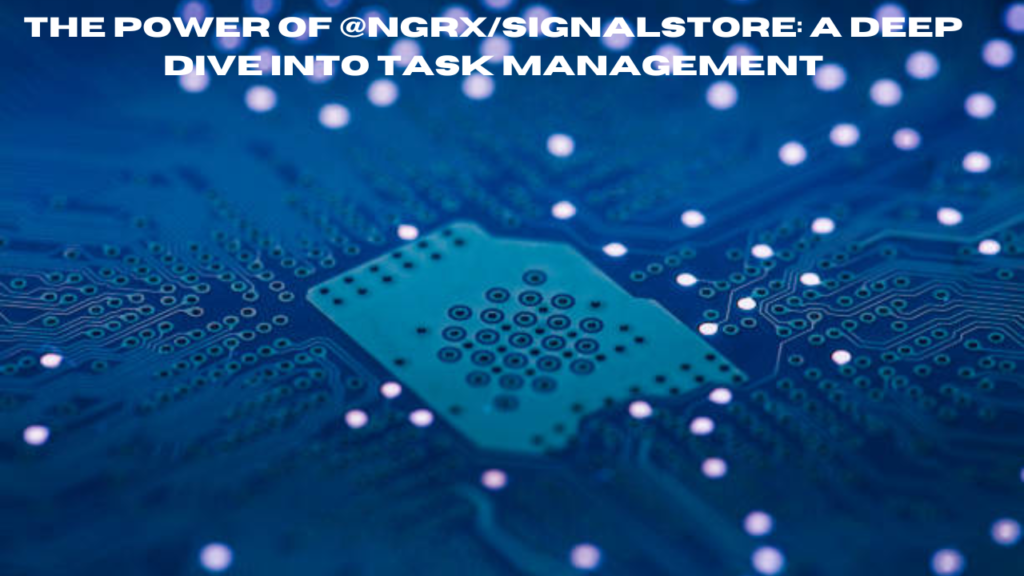In modern web development, managing the state of an application efficiently is crucial, particularly when dealing with complex tasks and dynamic data. One of the most effective ways to approach this in Angular applications is through the power of @ngrx/signalstore: a deep dive into task management. While @ngrx/signalstore may not be a widely recognized library within the NgRx ecosystem, the core concepts of reactive programming and state management—like signals and centralized stores—are pivotal in creating powerful and scalable solutions for task management.
Let’s explore how integrating the power of @ngrx/signalstore: a deep dive into task management can simplify complex workflows, enhance maintainability, and improve testing and debugging.
Understanding Signals in Task Management
At the heart of reactive programming lies the concept of signals, which can be implemented through technologies like RxJS or Angular Signals. These signals are streams of values that are emitted over time, enabling real-time updates and interaction with data. In the context of task management, signals serve various important roles:
1. Tracking Task Status
With signals, you can effectively track the status of a task, such as whether it is pending, in progress, or completed. A signal could emit updates whenever the task status changes, ensuring the application reflects real-time data.
2. Monitoring Task Progress
For long-running tasks, such as file uploads or API calls, signals can emit progress updates. This allows the UI to dynamically reflect the completion percentage, providing users with feedback and enhancing user experience.
3. Handling Task Results
Once a task is completed, signals can be used to emit the result, whether it’s success or failure. This allows components to react to changes in task results and trigger appropriate actions, like showing notifications or updating the UI.
4. Triggering Task Actions
Signals can also act as triggers for initiating task-related actions. For example, when a user clicks a button to start or cancel a task, a signal can trigger the corresponding state update, enabling seamless interaction between the user interface and backend processes.

The Role of State Management in Task Management
State management plays a pivotal role in ensuring consistency and predictability within Angular applications. With tools like NgRx, Akita, or custom solutions, managing task data in a centralized store simplifies the flow of information and maintains a single source of truth.
1. Centralized Task Store
A centralized store holds all the relevant task data, such as task IDs, descriptions, statuses, progress, and assigned users. With the power of @ngrx/signalstore: a deep dive into task management, having all this data in one place reduces the risk of inconsistencies and makes accessing task-related information easier and faster.
2. Predictable State Updates
State management frameworks like NgRx follow a strict pattern for state updates through actions, reducers, and selectors. This predictability makes debugging easier and ensures that the state transitions follow a clear path. In task management scenarios, each task-related action (e.g., starting, updating, or completing a task) can trigger state changes that are predictable and traceable.
3. Enhanced Data Consistency
By having a single source of truth, the data across the application remains consistent. When task information is updated in one part of the system, all other components that rely on that data are automatically updated, preventing data duplication or inconsistency.
4. Improved Testability
With task-related logic and state management centralized, testing becomes significantly easier. You can test actions, reducers, and selectors in isolation, ensuring that the task management system works reliably and consistently under different conditions.
Combining Signals and State Management for Efficient Task Management
When you combine the power of signals with a state management solution, you unlock the full potential of task management in your Angular applications. By leveraging both of these tools, you can build a dynamic, reactive, and highly maintainable system that is perfect for managing complex workflows.
1. Task List Component
A task list component can subscribe to signals that derive task data from the state store. Whenever the state changes—such as when a task is completed or its status is updated—the component will automatically re-render with the updated data. This ensures that the user interface is always in sync with the application’s state, providing a seamless experience for users.
2. Task Details Component
In addition to the task list component, a task details component can be used to display information about a specific task. By selecting the relevant task from the state store using its unique ID, this component can show detailed information such as the task description, progress, and status. As the task status or progress is updated, the component will automatically react to these changes.
3. Task Actions and User Interactions
User interactions play a key role in task management. When a user clicks a “start task” button or updates a task’s details, these actions can dispatch signals that trigger state updates. For example, starting a task might dispatch an action to update the task’s status in the store, which in turn triggers a signal to notify other components that the task is in progress.
4. Effects and Side Effects
NgRx Effects are an essential part of handling side effects in Angular applications. When dealing with tasks, side effects might include making API calls to create, update, or delete tasks. For example, when a task is added, an effect can be used to make an HTTP request to a backend server to persist the task. Once the request is completed, a new action can be dispatched to update the state, which in turn triggers changes in the UI.
Example: Simplified Task Management with Angular Signals
Let’s take a look at a simplified example using Angular signals and a basic store implementation to demonstrate how the power of @ngrx/signalstore: a deep dive into task management can be applied.
typescriptCopyEdit// Task interface
interface Task {
id: number;
description: string;
status: 'pending' | 'in progress' | 'completed';
}
// Simplified store (could be NgRx or something else)
class TaskStore {
private tasks = signal<Task[]>([]); // Use Angular Signals
getTasks() {
return this.tasks; // Return the signal
}
addTask(task: Task) {
this.tasks.update((currentTasks) => [...currentTasks, task]);
}
updateTaskStatus(id: number, status: Task['status']) {
this.tasks.update((currentTasks) =>
currentTasks.map((task) => (task.id === id ? { ...task, status } : task))
);
}
}
// Task list component
@Component({ /* ... */ })
class TaskListComponent {
tasks = this.taskStore.getTasks(); // Access the signal
constructor(private taskStore: TaskStore) {}
startTask(id: number) {
this.taskStore.updateTaskStatus(id, 'in progress');
}
}
This simple example showcases how signals and state management can come together to handle task updates reactively. As tasks are added or updated, the UI components that rely on this state will automatically reflect these changes.
Key Benefits of Using Signals and State Management
1. Reactivity
The primary advantage of using signals is that they provide a reactive model of task management. Any changes in the task data—whether the task status is updated or progress is made—are immediately reflected in the UI, without the need for manual updates or re-rendering.
2. Maintainability
Centralized state management makes the application easier to maintain. All task data resides in a single place, and updates to the state are handled in a predictable manner. This reduces the complexity of managing tasks and allows developers to easily identify and fix issues.
3. Testability
With clear separation between state management, signals, and UI components, testing becomes straightforward. Developers can write unit tests for state updates, task actions, and components to ensure that the task management system works as expected.
Also read: Buy Ezocards – The Ultimate Guide to Virtual Prepaid Cards

4. Data Consistency
By using signals and a centralized store, data consistency is ensured throughout the application. Any update to the task state is reflected in all components that subscribe to that state, preventing issues related to stale or inconsistent data.
Conclusion
The power of @ngrx/signalstore: a deep dive into task management provides a robust and scalable solution for managing tasks in Angular applications. By combining the power of signals with state management, developers can create reactive, maintainable, and highly testable systems. The ability to track task progress, handle user interactions, and manage state predictably allows for seamless workflows and a better user experience. Whether you are building a simple task manager or a complex application, leveraging these tools will make task management smoother and more efficient.




















































I have been absent for a while, but now I remember why I used to love this web site. Thanks , I will try and check back more often. How frequently you update your website?